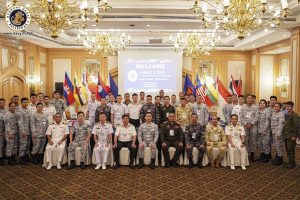From May 11 to 16, the Philippine Navy had the opportunity to host the second iteration of the Association of the Southeast Asian Nations (ASEAN)’s Multilateral Naval Exercise (AMNEX). Navies from Brunei, Indonesia, Malaysia, Singapore, Thailand, and Vietnam participated in the AMNEX’s sea phase trials at Bataan and Zambales provinces, to hone their interoperability against nontraditional security threats such as piracy, terrorism, and transnational crimes. Representatives from Cambodia, Laos, and Myanmar also attended the event as observers.
Aside from the sea phase trials, the ASEAN member states also participated in the 17th ASEAN Chief of Navies’ Meeting (ACNM), during which they agreed to set up guidelines for maritime interaction and approved the ACNM’s 2023-2032 roadmap, including the conduct of AMNEX itself. The AMNEX also came with the ASEAN Fleet Review held at Zambales, as well as the first-ever Philippine Fleet Defense Expo 2023 at Sangley Naval Base in Cavite province.
This year’s AMNEX theme, “Guardians of the Seas: Ensuring National Sovereignty, Security, and Stability,” succinctly reflects the Philippines’ foreign policy challenge today amid the backdrop of the South China Sea disputes, tensions over the Taiwan strait, growing China-U.S. competition, and the war in Ukraine – all of which shape Manila’s strategic choices. According to Philippine Defense Officer-in-Charge Carlito Galvez Jr., hosting the interrelated ASEAN events reflects the country’s position of fostering interoperability and cooperation in order to promote rules-based and safe maritime operations.
While the Philippines has been at the forefront of world politics since the 2010s, from its arbitral victory in the South China Sea to its flip-flopping foreign policy, it has never been more critical for Manila to stand its ground in the current uncertain strategic environment. Under President Ferdinand Marcos Jr., the Philippines has officially embraced its middle power status – and advanced a middle power narrative in order to shape and guide its policy trajectory.
In the first half of 2023, the Philippines has pulled its weight as a middle power by delicately balancing competing powers and playing a role on various issues of global import. This includes Marcos’ state visits to China, the United States, United Kingdom, Japan, Malaysia, and soon, France. It was also reflected in the president’s phone call with Ukrainian President Volodymyr Zelenskyy, the upgrade of the Philippine-U.S. security alliance through the expansion of the Enhanced Defense Cooperation Agreement and Balikatan military exercises, the government’s diplomatic handling regarding China’s laser-tagging incident and tensions over Taiwan, and Manila’s push for the Code of Conduct in the South China Sea.
The AMNEX-2 has further added to Manila’s middle power momentum. The exercise reflects the Philippines’s commitment to strengthening its naval diplomacy as it modernizes its defense capabilities. Two years ago, then navy chief Giovanni Carlo Bacordo said that the Philippine Navy’s commissioned frigates – the BRP Jose Rizal and BRP Antonio Luna – would be key instruments for signaling the Philippines’ commitment to protecting its interests as well as the willingness to cooperate with others concerning those interests. On the navy’s 125th anniversary, Marcos highlighted the need for country’s naval force to serve as “peaceful emissaries” of Manila, in conjunction with the AMNEX-2 and related ASEAN naval exchanges.
Vietnam was supposed to host the AMNEX-2 in 2020, but the exercise was canceled because of the COVID-19 pandemic; the baton was passed to the Philippines instead. Coincidentally, days after the conclusion of AMNEX-2 determination Hanoi rebuked Manila for placing buoys in the Spratly Islands, warning the latter that such actions violated its sovereign rights. The Philippines responded by saying that the buoys were merely intended to improve safety in navigation. This anecdote suggests that cooperation in one regard does not mean discounting other concerns between member states. Moreover, it also hints at the risks of being more assertive on the regional stage.
For all of its flaws, it could be said that having ASEAN is better than not having it. Yet an “obsolete ASEAN” poses a critical question for many in light of the growing great power competition between the United States and China. So far, the AMNEX cannot be expected to act as a precursor of a unified naval force, since ASEAN is far from a security alliance. Instead, AMNEX allows the Philippines to find new ways to improve its naval doctrines and monitor its ASEAN neighbors’ conventional capability, technological standards, and political temperance and attitudes regarding naval trends in the region and the world.
If there is anything to learn about the predominantly continental war in Ukraine, war at sea poses a critical battleground that all states must prepare for. In short, naval diplomacy, such as the AMNEX-2, is about anticipating potential risks and threats and doing something about them if necessary. This will be vital if the Philippines is to be more effective in strengthening its legs, widening its vision, and flexing its arms as a middle power should. The only price to pay is the fact that not everybody is going to like it.

































